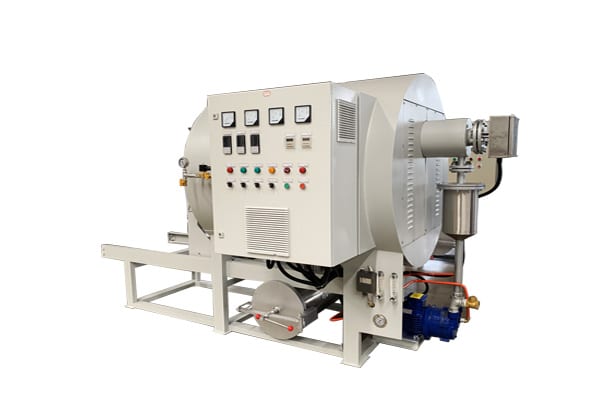Industrial vacuum cleaning oven efficiently and eco-friendly remove stubborn polymer residues from key parts like extruder screws, molds, and spinnerets by precisely controlling temperature, maintaining high vacuum, allowing sufficient time, and optionally using steam, ensuring optimal cleaning and extended equipment life.
In industries like plastic extrusion, chemical fiber spinning, and injection molding, polymer residues (charred deposits, carbon buildup) on equipment parts are a major headache. They harm product quality, reduce efficiency, and shorten equipment lifespan. Traditional chemical cleaning is inefficient, polluting, and ineffective for precision parts. Industrial vacuum cleaning ovens offer a superior solution: efficient, eco-friendly, and non-destructive. Let’s explore what they clean best and how to optimize results.

Part 1: What Does a Vacuum Cleaning Oven Clean? Key Targets
- Core Processing Parts:
- Extruder Screws & Barrels: Prime spots for residue, especially with high-temp, decomposable materials (like PVC, fluoroplastics) or frequent material/color changes. Vacuum cleaning removes stubborn carbon deposits and degraded material.
- Molds: Includes injection molds, extrusion dies (sheet, pipe, profile), and blow molds. Complex channels and surfaces trap residue, causing defects (flow marks, black specks). Vacuum cleaning cleans thoroughly, restoring precision.
- Spinnerets / Spinning Assemblies: Critical in chemical fiber. Tiny holes clog easily. Vacuum cleaning restores hole flow and spinning stability.
- Key Auxiliary Parts:
- Filters (Screens, Cartridges): Trap impurities and polymer. Vacuum cleaning breaks down organics, restoring performance.
- Melt Pumps, Gear Pumps: Precision gears jam easily.
- Valves, Pipes, Adapters: Residue in connections and dead spots.
- Pelletizing Dies & Cutters: Clogged holes and surface adhesion.
- Other: Core parts of lab-scale equipment, heavily contaminated tools/fixtures.
Part 2: How to Get the Best Results? Key Strategies
Vacuum cleaning https://8ruiyan.com/en/all-vacuum-cleaning-furnaces/uses high heat (below polymer melting point) and vacuum (low pressure). Residual polymers undergo thermal cracking and oxidative decomposition. The resulting small gas molecules are removed by the vacuum pump. Maximize results with these key points:
- Set Temperature Precisely:
- Adjust Based on Material: Different polymers crack at different temperatures. Typical range: 350°C – 550°C.
- E.g., PE/PP: ~400-450°C; PET/PA: ~450-500°C; PVC: ~350-400°C (beware corrosion); Fluoroplastics need higher temps (>550°C).
- Preheat Thoroughly: Preheat 1-2 hours before cleaning. Ensures even oven temperature. Prevents part stress or uneven cleaning.
- Zone Control is Better (Premium Ovens): Ideal for large/complex parts (long screws). Eliminates dead zones.
- Adjust Based on Material: Different polymers crack at different temperatures. Typical range: 350°C – 550°C.
- Maintain High & Stable Vacuum:
- Deep Vacuum is Core: High vacuum (< 100 Pa or even < 10 Pa) is crucial. It:
- Lowers cracking temperature.
- Speeds gas removal, preventing redeposit.
- Creates low-oxygen environment. Reduces charring and ash.
- Stability is Key: The vacuum system (pump, seals) must be reliable. Maintain stable low pressure. Leaks introduce oxygen, increasing char.
- Deep Vacuum is Core: High vacuum (< 100 Pa or even < 10 Pa) is crucial. It:
- Allow Enough Time:
- Time depends on part size, contamination level, material, and temperature. Typically hours to over ten hours.
- Practical Tip: Watch vacuum pump exhaust smoke (thick -> thin -> nearly clear). Never cut time short. Results suffer.
- Use “Catalysts” Wisely (Highly Effective Options):
- Steam (Recommended): Introduce small, controlled amounts under heat and vacuum:
- Speeds up hydrolysis, boosting efficiency and shortening time.
- Helps break up carbonized layers.
- Leads to more complete decomposition. Significantly less ash residue. Parts come out cleaner.
- Steam (Recommended): Introduce small, controlled amounts under heat and vacuum:
- Optimize Loading & Operation:
- Avoid Overloading: Leave space between parts. Ensure hot air/steam circulates. Follow max load limits. Overcrowding causes uneven heating and poor cleaning.
- Simple Pre-Cleaning: For parts with heavy carbon buildup, scrape off loose chunks first. Slightly improves efficiency.
- Place Parts Properly: E.g., Support screws horizontally to prevent sagging; keep mold channels unobstructed.
- Clean Oven Regularly: Remove accumulated ash. Prevents efficiency loss or part contamination.
- Maintenance & Records are Essential:
- Maintain Equipment Diligently: Regularly service the vacuum pump (change oil), seals, heaters, etc.
- Keep Detailed Records: Log each job: part, contamination, temperature, vacuum level, time, steam/gas use, results. Build a database. Optimize processes and troubleshoot faster.
For further consultation, please contact our technical team for expert advice.
Whatsapp:86-19106101570
wechat:86-19106101570
email:nieyili@cnryan.com
